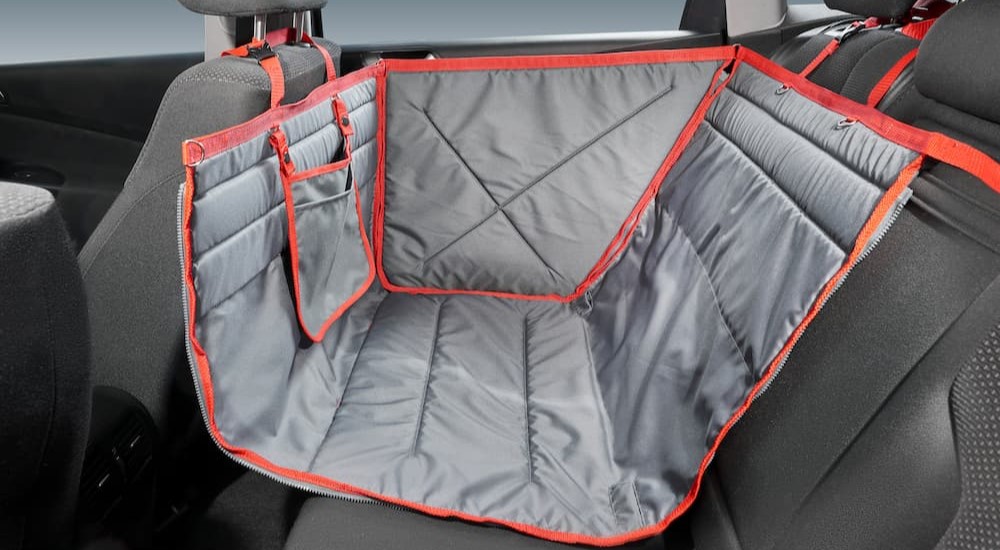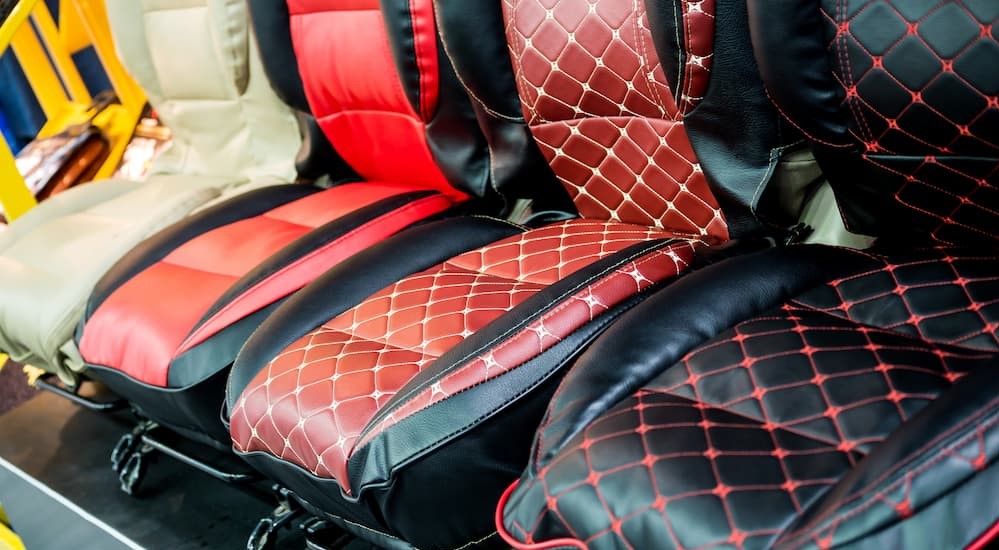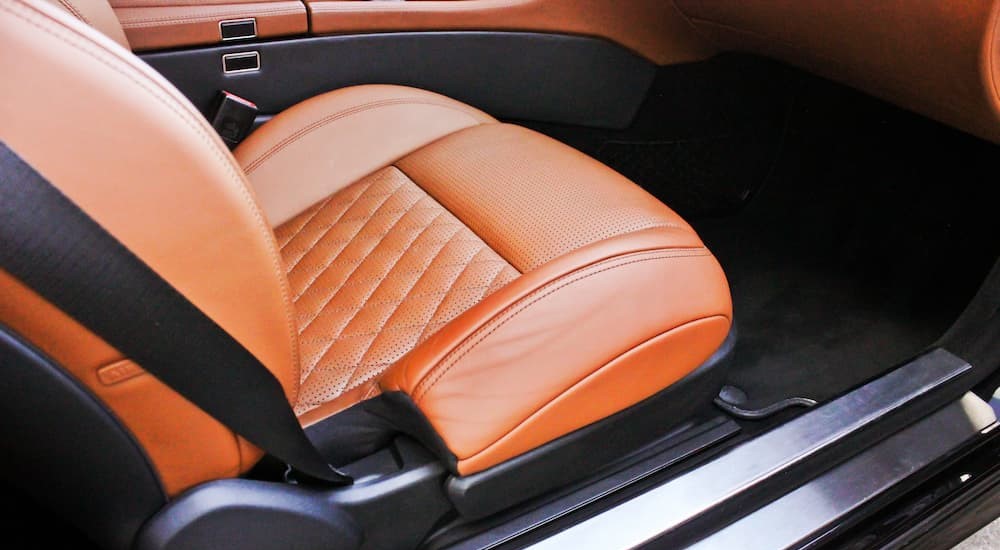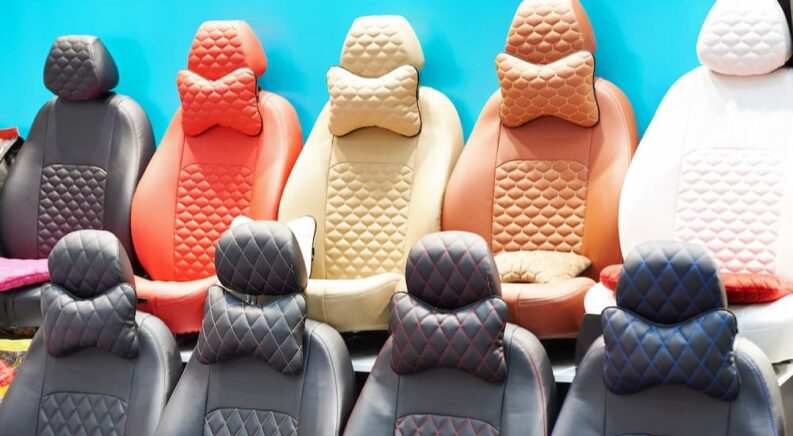When it comes to customizing a vehicle, drivers take all sorts of different approaches. Some start with performance-minded upgrades: swapping out stock tires, mufflers, and air intakes for new-and-improved components that add vital power and control. Others focus more on the exterior, giving their vehicle a splashy new paint job or window tint that is sure to turn heads on the highway. These exterior upgrades can go a long way in setting a car apart from the crowd, but there’s only one problem: they’re hard to appreciate while you’re sitting inside your vehicle. This is where interior upgrades come in. From aftermarket stereo systems and ambient lighting to steering wheel and seat covers, interior upgrades allow every driver to turn their car into a four-wheeled expression of their style.
Seat covers might not be the most flamboyant way to customize an interior–that honor would probably have to go to the 8-ball shift knob or timeless fuzzy dice–but they can have a major effect on the whole driving experience. There are lots of reasons to upgrade your vehicle’s seat cover over the stock upholstery that it left the factory with. Whether you’re looking for a more comfortable seat, better protection from spills and crumbs, or a bold new color to set off the interior, seat covers are one of the easiest ways to put your stamp on the interior of your car, truck, or SUV. Let’s take a look at some of the advantages of seat covers, explore the differences between universal and custom options, and consider the different types of materials used.

Advantages of Seat Covers
Protection
For most drivers, car seat covers are all about protecting what’s underneath. From rain and mud to spilled drinks, fast-food stains, and even burns, there are plenty of threats facing our vehicle’s upholstery daily. A car seat cover is your first line of protection against such threats, providing a defensive layer between your original upholstery and the sticky, messy world outside. This might not be as much of an issue if you’re planning to run your car into the ground, but for those who see a potential resale down the line, this sort of protection can be vital in helping a vehicle maintain its value by slowing its depreciation.
Comfort
Today’s car seats are designed with ergonomics in mind and while a lot of time and effort goes into making them as comfortable as possible, the one-size-fits-all approach has its shortcomings. Everyone’s body is different, making it difficult to build a seat that will satisfy every driver, not to mention our varying thresholds for comfort and different driving postures. Adjustable seats allow for some customization, but seat covers can make a big difference when it comes to introducing some extra padding into the equation. Not all aftermarket seat covers are designed for comfort, but those that are can provide a noticeable improvement over the stock seats, especially on longer rides or bumpy off-road excursions.
Style
When it comes to seat covers, there’s no discounting aesthetics. Aftermarket seat covers–especially custom versions–are a great way to tie the whole interior together, providing a bold, luxurious look that can allow a vehicle to punch well above its price range in the looks department. Seat covers can be keyed to the exterior paint job or a vehicle’s overall aesthetic, providing a pop of color that is sure to earn you a nod of approval at the next cruise-in night.

Universal vs. Custom Options
Car seat covers are generally broken down into two distinct categories: universal and custom. Universal car seat covers, as one might guess, can be used on a wide variety of makes and models. This one-size-fits-most approach has both advantages and disadvantages, with their relatively lower price being a major selling point. Universal car seat covers are also often easier to remove than custom versions, which makes for quicker cleaning and repair. Simply remove the car seat cover, throw it in the wash and you’ll be able to erase months of stains, spills, and other imperfections with ease.
Universal seat covers are typically made from stain- and water-resistant poly cotton twill material which, while not always the most stylish fabric, does a great job of resisting blemishes. The major disadvantage of universal seat covers comes down to the fit. While these covers usually feature some sort of non-slip backing and velcro or zipper closures, they’re just never going to be quite as snug as custom options or the original factory seats. This might not be an issue for some drivers, but those who spend a lot of time at the track won’t appreciate the feeling of their backside sliding around as they’re cornering thanks to an ill-fitting seat cover.
This sort of slipping and sliding around is less of an issue with custom seat covers, which are generally far more snug and tailored to a specific make and model. They usually share the same spill- and stain-resistant properties as their universal cousins and often come with extra foam and support as a means of improving comfort. The right set of custom seat covers can bring a seamless look to any interior, and some higher-end options are virtually indistinguishable from the original factory seats.
Of course, this sort of customization comes at a price: custom seat covers often retail for far more than universal offerings. They can also be more difficult to install, with their tight-fitting, custom design often necessitating professional installation. They might not be as easy to install or maintain as universal seat covers, but for those seeking a premium look and feel, they’re hard to beat. Choosing the right cover is about more than price and style, however, since the material it’s made from is just as important.
Common Types of Material
Ballistic nylon
If you ever wanted to feel like you’re driving around while sitting on a military-issue flak jacket, ballistic nylon seat covers are the answer to all your dreams. Incredibly durable, thick, and strong, ballistic nylon seat covers are one of the best options if you’re seeking exceptional UV and water protection. The downside is pretty obvious: they’re not going to be the most comfortable seats in the world, but they will do a great job of protecting your upholstery.
Canvas
If it’s good enough for workwear, it’s good enough for your car seats. Canvas seat covers are an affordable option that is also surprisingly resistant to fluids, dirt, and grime. While they are the perfect choice for an off-road or adventure vehicle, they’re not necessarily the most stylish option on offer, though they will match your Carhartts.
Neoprene
The go-to material for wetsuits also happens to be a decent option when it comes to car seat covers. If waterproofing is a big concern, it’s hard to do better than neoprene, making it a great option for those with small children or other spill-prone family members. Neoprene seats can lend a vehicle a sporty look, but the dense, water-resistant material does have one major drawback: it doesn’t breathe very well. This can be an issue on longer rides or hot days, causing serious comfort issues as heat and moisture become trapped between the driver and their seat cover.
Leather
Looking to add a touch of class to your vehicle’s interior without skimping on protection? Leather seat covers are the way to go. While they might be more prone to water and UV damage than some other options, there’s no substitute for the sense of luxury they can impart. The major drawback of leather seat covers comes down to comfort because while leather might feel nice against the skin, it also absorbs heat in a way that can cause issues on a warm summer day.
Suede
Since suede is essentially a type of leather, it comes with many of the same pros and cons listed above. It’s durable and provides great UV protection, but is especially susceptible to damage from water and other liquids. Some drivers might also be turned off by the unique feel of suede, which is almost like a slightly fuzzier version of leather, but that same drawback is a selling point for others.
Saddle Blanket
If you’re looking to give your ride a unique, Old West touch, it’s hard to beat a saddle blanket-style seat cover. Typically woven from colorful fabrics, saddle blanket seat covers are a warm and inviting option that will add a bright sense of fun to any interior. I think this option pairs particularly well with older pickups, which will look ranch-ready with the addition of saddle blanket seat covers. They’re also warm and durable, making them a great choice for a variety of climates and conditions.
Velour
If you want to give your vehicle all the appeal of an ‘80s tracksuit, velour seats might be the right choice for you. Made from cotton or polyester, velour provides a feel that’s similar to velvet while typically costing a little less. That said, it’s not the most functional choice on the list as it offers little in the way of water or stain protection, making it much more about style.

Now Get Out There and Cover Your Seat
If you’re looking to up your vehicle’s luxury factor, improve comfort, or protect its resale value, aftermarket seat covers are the way to go. Coming in all shapes, sizes, and designs, these covers provide an important layer of added protection that will shield your vehicle’s upholstery from the rigors of everyday driving. While choosing a seat cover largely comes down to personal preference, there are some important factors to keep in mind when making the decision. Start by setting a budget and choosing between universal and custom covers, keeping in mind their installation costs in both time and money. Once that’s settled, you can begin to explore different fabric options ranging from military-grade ballistic nylon to soft, supple leather and everything in between. Remember, customization is one of the great joys of vehicle ownership and there’s no discounting the effect that a new set of seat covers can have on even the oldest, most time-tested ride.

